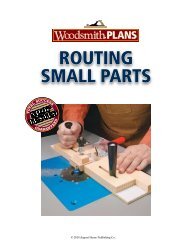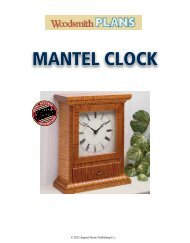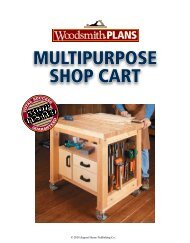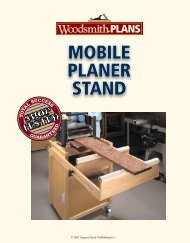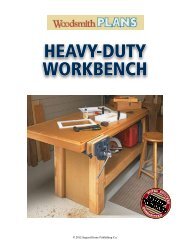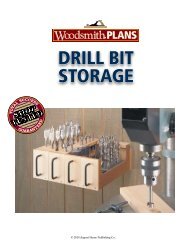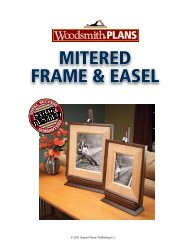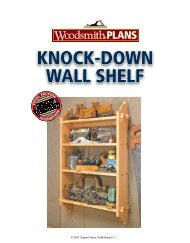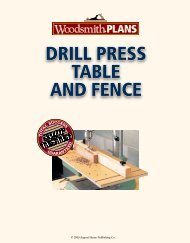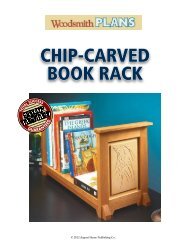Create successful ePaper yourself
Turn your PDF publications into a flip-book with our unique Google optimized e-Paper software.
The <strong>Mortise</strong><br />
There’s more to making a mortise<br />
than simply hacking out an opening<br />
in a workpiece. Anytime I’m making a<br />
mortise, I’m concerned with a couple<br />
of things — speed and accuracy.<br />
I want a quick way to remove the<br />
material from the workpiece to create<br />
the mortise. But I also want to make<br />
sure the ends of the mortise are<br />
square with the sides, and the sides<br />
are square with the face of the workpiece.<br />
This is important if you want to<br />
get a good fit with the tenon.<br />
DRILL PRESS METHOD<br />
One of the simplest methods available<br />
that satisfies both of these requirements<br />
is to use a drill press to remove<br />
most of the waste of the mortise (Fig.<br />
1). Using a Forstner or brad point bit,<br />
I drill a series of overlapping holes<br />
to create a rough opening. Then I<br />
square up the ends and sides of the<br />
mortise with a chisel, (Fig. 2).<br />
<strong>Shop</strong> Note: If your workpiece is<br />
too long or heavy to place on a drill<br />
press, try using a handheld drill with<br />
a dowel jig to guide the drill bit.<br />
There are a couple of things I<br />
like about this method (which is<br />
probably why I use it more than<br />
any other). First, it doesn’t require<br />
any lengthy setup of equipment.<br />
The width of the mortise is determined<br />
by the diameter of the drill<br />
bit and the depth by the depth stop<br />
on the drill press. All you need is<br />
a simple fence clamped to the drill<br />
press table to establish the position<br />
of the mortise in the workpiece.<br />
Second, it allows me to see my work<br />
at all times. As I’m drilling the row of<br />
3<br />
1 2<br />
holes, it’s easy to tell if I’m wandering<br />
outside of my layout lines.<br />
As useful as it is, drilling a series<br />
of holes and cleaning up the sides of<br />
each mortise with a chisel can be a<br />
time-consuming task, particularly if<br />
you have a lot of mortises to make.<br />
For some projects, it makes more<br />
sense to use a different technique.<br />
ROUTER METHOD<br />
Sometimes I need to make a series<br />
of identical mortises in a workpiece.<br />
For example, if I’m building a project<br />
with a row of slats or spindles, I use a<br />
router to cut the mortises.<br />
Using an edge guide or a shopmade<br />
jig, it’s possible to rout a series<br />
of mortises in less time than it would<br />
take to drill them on a drill press, see<br />
Fig. 3. It’s simply a matter of setting<br />
up the edge guide and routing a slot<br />
for each mortise.<br />
<strong>Shop</strong> Note: I don’t like to take<br />
more than a 1/4"-deep cut on any single<br />
pass. If I need to make a mortise<br />
deeper than this, I’ll take multiple<br />
2 www.<strong>Woodsmith</strong>.com © 2007 August Home Publishing Co. All Rights Reserved.<br />
4<br />
passes, lowering the bit in between.<br />
And to prevent the slot from filling<br />
up with shavings, I also prefer to<br />
use spiral end mill bits rather than<br />
ordinary straight bits for routing<br />
mortises, see photo at right.<br />
Aside from the speed, the nice<br />
thing about a mortise that’s made<br />
with a router is the fact that it has<br />
perfectly smooth sides. The only<br />
handtool work that’s required is to<br />
square up the ends of the mortise<br />
with a chisel, see Fig. 4.<br />
DRAWBACKS. There are a couple of<br />
downsides to using a router for<br />
making mortises, though. First,<br />
although it’s possible to get by with<br />
a standard router, routing mortises<br />
is really a job that calls for a more<br />
expensive plunge router.<br />
But more importantly, I always<br />
feel like I’m sacrificing some control<br />
when I use a router. Since the router<br />
cuts a mortise so quickly (and you<br />
don’t have a clear view of the mortise<br />
while you’re routing), it only takes a<br />
split second to make a mistake.<br />
{ The deep flutes<br />
of a spiral end<br />
mill bit are<br />
designed to pull<br />
the shavings<br />
out of a mortise<br />
quickly.



